
Extended rehabilitation programs improve physical function after hip fracture .
This report has been verified
by one or more authors of the
original publication.
Extended Exercise Rehabilitation After Hip Fracture Improves Patients' Physical Function: A Systematic Review and Meta-Analysis
Phys Ther. 2012 Nov;92(11):1437-51. doi: 10.2522/ptj.20110274. Epub 2012 Jul 19.Exclusive Author Interview
Mohammad A. Auais (International Centre for Health Innovation, Western University) discusses the effect of extended exercise rehabilitation after hip fracture.
This meta-analysis included 13 randomized controlled trails (1107 fractures) that assessed the effects of an extended exercise rehabilitation program on the physical functioning of patients with hip fractures. The results of the meta-analysis and systematic review indicate that an extended exercise rehabilitation program improves knee extension strength, balance, physical performance based tests, the Timed "Up and Go" test, and fast gait speed when compared with a standard rehabilitation program for patients with hip fractures.
Unlock the Full ACE Report
You have access to 4 more FREE articles this month.
Click below to unlock and view this ACE Reports
Unlock Now
Critical appraisals of the latest, high-impact randomized controlled trials and systematic reviews in orthopaedics
Access to OrthoEvidence podcast content, including collaborations with the Journal of Bone and Joint Surgery, interviews with internationally recognized surgeons, and roundtable discussions on orthopaedic news and topics
Subscription to The Pulse, a twice-weekly evidence-based newsletter designed to help you make better clinical decisions
Exclusive access to original content articles, including in-house systematic reviews, and articles on health research methods and hot orthopaedic topics

































































